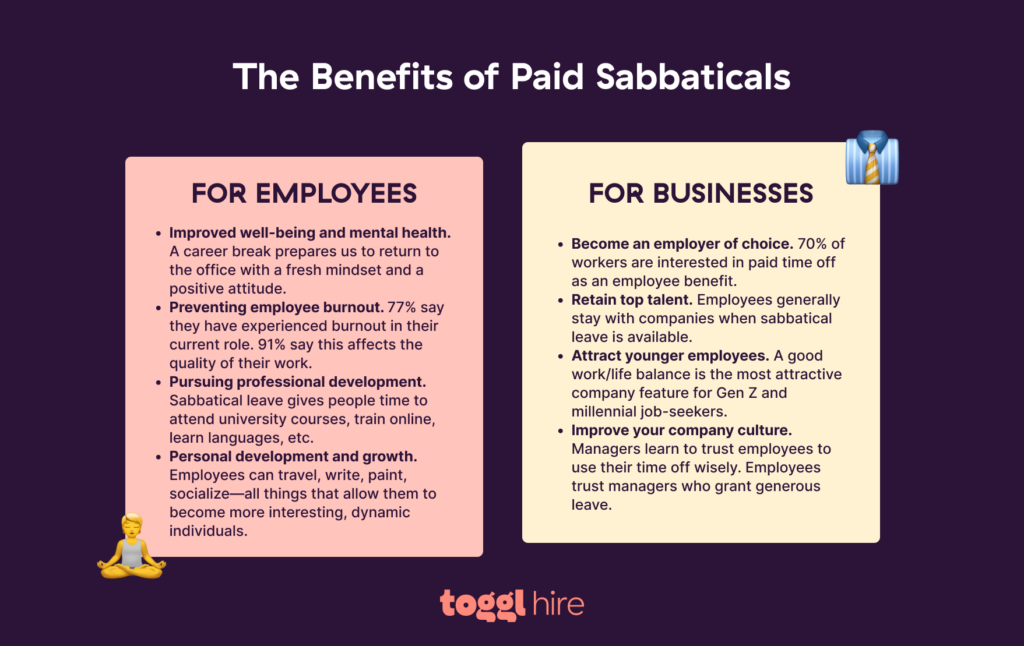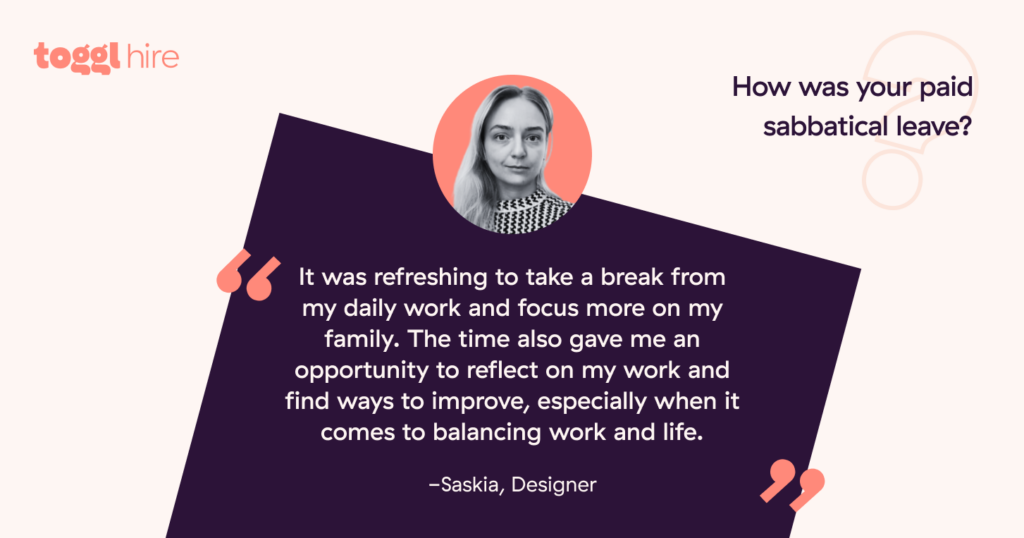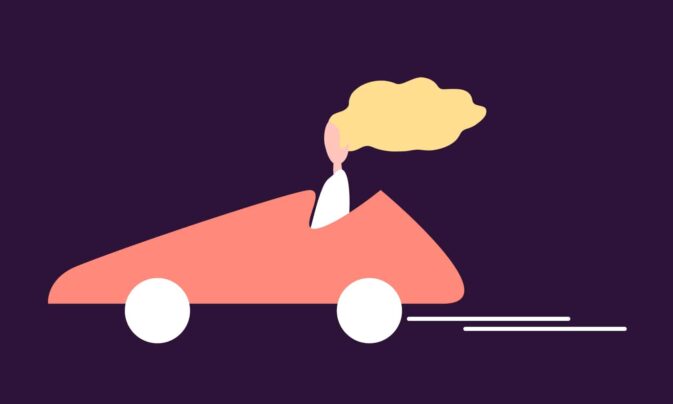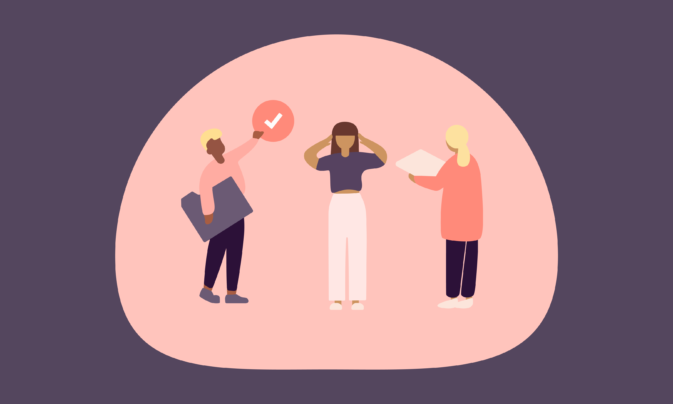Absence makes the heart grow fonder. But what if that applies to job satisfaction, too?
HR experts increasingly believe that getting away from work benefits individuals as well as the organizations they work for.
More companies are realizing the benefits of sabbaticals as a tool for employees to recharge and gain perspective, returning refreshed and reenergized to tackle their work tasks.
Plus, as an antidote to employee burnout, a paid sabbatical can also help improve staff retention and morale, allowing employees to find balance or develop skills away from workplace pressures.
We know because we offer such perks. The details may seem fuzzy right now, but stick with us as we explore the very underrated value of sabbatical leave.
TL;DR — Key Takeaways
Sabbaticals allow employees time away from work to relax and recharge, improve their mental health, learn new skills, complete a hobby project, or explore the world.
A sabbatical can be paid or unpaid. Sabbatical lengths and eligibility criteria also vary. Some companies offer sabbaticals after a few years of service. Others require longer periods.
Sabbatical leave benefits include better well-being, personal growth, and career development. Employers benefit through better morale, job satisfaction, and staff retention. Sabbaticals boost employer brands, making recruitment easier.
Sabbatical policies clearly explain how to apply and what benefits are available. The best policies are communicated clearly, have defined sabbatical lengths, and state whether they are paid. Remember to plan for continuity, too. This avoids short-staffing when employees take time off.
Combine employee benefits with efficient recruitment to source the best talent. At Toggl Hire, we offer generous sabbatical benefits and use skills-based recruiting tools to identify and attract talented newcomers. Try our approach to improve performance across the board.
What is sabbatical leave?
Employers may grant extended leave periods known as sabbaticals. Unlike sick leave and maternity leave, sabbaticals are more open and dedicated to personal growth (yes, rest is part of growth), and they could transform your HR strategy.
Sabbaticals are used for various reasons. Workers may experience burnout and need time to recharge, pursue personal interests, or travel. Sometimes, sabbaticals mix leisure and professional development, enabling workers to hone their skills and gain knowledge without distractions.
Sabbaticals can also be strategically important for employers. When used in the right way, it can be a tool for boosting staff retention and morale. They are never just periods of absence.
How long is a sabbatical?
Sabbatical durations range from a few weeks to a year, and length varies by organization and purpose.
For example, if someone wants to take extended time off after a stressful project, a one-month sabbatical may be enough. When employees intend to learn a demanding technical skill or scale the Himalayas, a longer career break may be needed.
Sabbatical policies differ between organizations, too. For example, sabbatical leave rules may assign leave based on tenure or departmental needs. At Toggl, we offer four weeks of paid sabbatical leave after three consecutive years of service.
Other sabbatical leave policies differ. For instance, Nike offers five weeks of paid leave after 10 years of service, while many businesses don’t offer time off at all.
With only 5% of US companies operating a formal sabbatical policy, extended leave remains a valuable point of difference to potential employees when comparing your organization to other companies.
Is sabbatical leave paid or unpaid?
Usually, it’s up to the company. When a company has to decide between paid and unpaid sabbatical time, it doesn’t always mean they aren’t being generous. Some companies simply can’t afford to give it to their workers.
That being said, not all workers are in a position to go on unpaid sabbaticals if they need the money, even though they want a break from work. However, both have their pros and cons.
Unpaid sabbaticals are much cheaper for companies and affordable for smaller businesses. They tend to be shorter, reducing the risk of leaving posts unfilled. Discounted training or other perks that can be used during the career break can also help employees use unpaid leave.
Paid sabbaticals are expensive but provide more space for employees to pursue career development or check out entirely (the latter is what we encourage our employees to do!). Employees have fewer financial worries (a critical contributor to stress and burnout), and they can return to work happier, relaxed, and less worried about their bank balance.
Don’t have the budget to offer paid sabbatical leave? There are plenty of ways to tailor sabbatical policies to business needs. For example, HR teams can:
-
- Mix short-term unpaid sabbaticals and longer-duration paid leave.
-
- Pay for employees to upskill without taking extended time off.
-
- Set sabbatical windows when employees are eligible for paid leave and allow unpaid sabbaticals at other times.
-
- Only allow sabbaticals if other employees organize cover.
The benefits of paid sabbaticals (for you and your employees)
We recommend granting paid sabbatical leave wherever possible. That’s not just because we’re nice. The concrete advantages of paid leave make it an attractive benefit for employers and individuals. Again, we know this is true because we’ve seen it across our team for years.
On the employee side, sabbaticals make a huge health difference. According to one study, for every 10 days off work, depression rates drop 29%. When 76% of employees report at least one symptom of poor mental health, finding solutions matters.
Paid sabbaticals are equally transformative for employers. Childcare issues, lack of flexible hours, and miserly benefits are the three most commonly cited factors behind employees leaving. Paid leave solves all three.
Benefits for employees
Improved well-being and mental health. A career break prepares us to return to the office with a fresh mindset and a positive attitude.
Preventing employee burnout. 77% say they have experienced burnout in their current role. 91% say this affects the quality of their work.
Pursuing professional development. Sabbatical leave gives people time to attend university courses, train online, learn languages, and explore perspectives that broaden their professional horizons.
Personal development and growth. During extended leave, our time is our own. We get to be instead of do. We can travel, write, paint, socialize—all things that allow us to become more interesting, dynamic individuals.
Benefits for businesses
Become an employer of choice. 70% of workers are interested in paid time off as an employee benefit. If you can’t offer that, whether through sabbatical programs or generous paid time off, you’ll struggle to recruit the best talent.
Retain top talent. Employees generally stay with companies when sabbatical leave is available. For instance, Automatic created a paid sabbatical policy and now enjoys a 7.5% turnover rate—way below the 12% industry average.
Attract younger employees. A good work/life balance is the most attractive company feature for Gen Z and millennial job-seekers. Few businesses offer sabbaticals, so this is somewhere you can win big.
Improve your company culture. Managers learn to trust employees to use their time off wisely. Employees trust managers who grant generous leave. Sabbatical experiences enrich the organization, encouraging innovation and growth.
Sabbatical policies are simply more likely to work than standard leave quotas. 46% of US workers don’t take paid time off entitlements. Using the term sabbatical helps uptake by raising its status within the company.

How to build your sabbatical policy
Now that you’re aware of some of the benefits of sabbatical leave, let’s get practical. Companies need a structured sabbatical program to achieve results and manage expenses.
How you build a sabbatical program depends on your goals, workforce, and budget, but based on our experience, here are some best practices for organizing sabbatical leave.
1. Define eligibility criteria
Firstly, you need to define who is eligible for sabbatical leave. As noted earlier, you could grant leave based on years of experience. Experience-based policies encourage employees to stay for longer with the company, essentially offering them a long-term reward for loyalty.
Or, you might choose to use performance criteria to define employee eligibility for sabbaticals. This short-term approach suits project-based businesses where teams work under pressure.
When defining sabbatical eligibility, be clear and fair. No one should be left out, but you do have to consider what’s fair for your business, too. Ultimately, everyone should know what they’re entitled to and feel empowered to claim the leave if needed.
2. Determine duration and frequency
Policies must also determine sabbatical leave duration and frequency.
Getting both right is a tricky balancing act. Personally, most of us would love to grant our employees extensive leave, but budgets and business needs pull us in the other direction. Good policies fall somewhere between generosity and hard-headed strategy.
You might try linking sabbatical duration and frequency with the rhythm of business life. There may be windows when granting sabbatical leave is easy, such as summer slumps when most others are out on vacation anyway. At other times, you can’t do without experienced employees. Be transparent about business needs, and deliver on promises to defer leave if the timing isn’t right.
3. Decide on paid vs. unpaid leave
One study reports that 16% of US companies offer sabbaticals, but only 5% are paid. It might be tempting to follow the herd, but it’s worth taking paid leave seriously. Paid sabbaticals can be much more effective, allowing employees true freedom to shape their experiences. Just take it from one of our team members, who recently took hers:

Paid leave is also more common in certain industries. For instance, healthcare companies offer paid leave periods to recharge or upskill. Younger employees also tend to embrace sabbatical leave. As many as 8% of Gen Z workers are off work at any one time.
Unpaid sabbatical leave may miss these norms and cultural shifts, hurting your employer brand to critical groups.
We understand that paid leave can feel like an expensive luxury for smaller businesses. Partial pay is a potential solution. Covering less than full salary for part or all of a sabbatical period may help balance affordability and generosity.
4. Communicate the policy clearly
One of the biggest problems with PTO and sabbatical leave occurs when employees fail to take advantage of their time off.
You have a sabbatical policy because sabbaticals have value, so it makes no sense to be hush-hush about their sabbatical leave days and requirements or make applying unnecessarily complicated.
Clearly communicate when they’re eligible and provide simple steps for requesting time off. At Toggl, we even include tips from others about how to make the best use of their extended period away from the rest of us.

Use multiple channels to inform every employee of their sabbatical entitlements. Add this info to onboarding handbooks and internal websites (for us, that’s Notion, for example). If it’s helpful, have your HR or talent acquisition team remind employees of their sabbatical leave perks or host casual chats with employees who have taken their sabbatical to show others how beneficial it is.
5. Plan for operational continuity
Finally, sabbatical policies must consider business needs. Most companies can’t afford to lose 50% of their workforce for an extended period. Even a single employee leaving can cause havoc (without proper planning, that is).
So, make operational continuity part of your sabbatical process. Every time employees request to use sabbatical days, kickstart a process to organize cover while they’re out. This might look like hiring freelancers to help with a few ad-hoc tasks or asking junior employees to step up for a few weeks.
Set a lead-in period before someone’s sabbatical leave starts. Give yourself (and the employee who will be away for an extended period) time to prepare. Specify how much notice employees need.
Examples of sabbatical leave policies
Even with the guidance above, you may still have reservations about granting sabbatical leave. We get it. It’s new, and new things are sometimes scary.
That said, understanding real-world examples of sabbatical leave functioning smoothly should help you feel confident about offering extended leave policies.
Toggl
At Toggl, we take time off very seriously. All employees enjoy paid sabbatical leave. After three years of continuous employment, employees become eligible for a minimum of four weeks of sabbatical leave, which increases if they stay with the company for longer.
Everyone can apply, regardless of seniority or location. And we make the process as simple as possible (it’s literally three steps). We also provide some simple guidance about how to prepare for their leave. We aren’t global giants (although we’re getting there). However, sabbatical leave makes sense for us to keep teams fresh, attract talent, and maintain great employee morale.

Some of the tips we offer employees about how to prepare for their sabbatical include:
- Communicate about your sabbatical plans early enough, so all preparations can be made in due time.
- Wrap up your ongoing projects, or make sure to delegate their completion to someone else.
- Prepare for the comeback! It’s a good idea to have a rough plan of what you’ll need to do when you come back.
- Update your Slack status with the date you’ll be back and who is covering for you while you’re away. While this helps everybody know who to contact while you’re out, it also helps let people know you’re OOO and not to be bothered. 😉
Bank of America
Bank of America started its paid sabbatical policy in 2023, and its 200,000+ workforce is responding positively. By 2024, over 5,000 workers had taken paid time off to travel, care for relatives, or relax.
BoA’s scheme allows four weeks off after 15 years of service, five extra weeks after 20 or 25 years, and six weeks at the 30-year milestone. Staff can take two sabbatical breaks during their employment. They seem keen to do so.
Adobe
Software giant Adobe is a trendsetter in sabbatical benefits, operating a model schedule for its US workforce. Under Adobe’s sabbatical leave policy, employees qualify for four paid weeks at year five, five weeks after 10 years, and 6 weeks after 15 years.
There are some limitations, though. Employees have two years to claim time off after it becomes available, and the sabbatical leave policy only applies to US-based workers. Even so, it’s a generous template to copy.
Hire great employees who stick around
When it comes to recruiting, nothing can replace a great work environment, competitive salary, and real perks that actually help your workers invest in themselves and feel refreshed to get the job done.
Sabbaticals are a great way to help employees do this, as they provide space to pursue new skills or to simply relax and be human for a hot second. Basically, sabbaticals ensure that when you hire great talent, they don’t just stick around—they flourish.
However, you do need to ensure you’re hiring great talent in the first place—the kind that wants to stick around long enough to enjoy a sabbatical. We can help with that.
Our recruitment tools make it easy to source employees with the skills needed to succeed on the job while also ensuring they’re a great culture add to your team. With Toggl Hire, you can make more confident hiring decisions that benefit you and your new hires.
Create your free account now to start hiring. Then, get started on that sabbatical leave policy.
Elizabeth is an experienced entrepreneur, writer, and content marketer. She has nine years of experience helping grow businesses, including two of her own, and shares Toggl's mission of challenging traditional beliefs about what building a successful business looks like.






